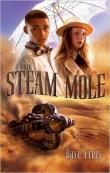AustLit
 5687642918544723285.jpg
5687642918544723285.jpg
Latest Issues
AbstractHistoryArchive Description
'Tim Barnabas is a submariner from the Cuttlefish, a coal fired submarine. Clara Calland is the daughter of a scientist who carries a secret formula that threatens British Imperial power. After a daring chase across the globe, they have brought the secret to Westralia. Here, much of Australia is simply too hot to be habitable by day. People are nocturnal, living underground and working outside at night. To cross the deserts they use burrowing machines known as "steam moles." With the Cuttlefish out of action, her crew takes jobs on these submarine-like craft.
Duke Malcolm, of the Imperial Security Service, transports Clara's rebel-father to a prison in Eastern Australia, hoping to bait her into attempting a rescue. Clara looks to Tim for help, only to find he has fled a racist incident into the desert. She takes a steam mole in search of him. The two head to Eastern Australia, where they discover an invading force with plans to take Westralia. Forced to survive in the desert, they encounter the intolerance meted out to the aboriginal people. Can they save Westralia from falling under British rule? And should they?'
Source: Publisher's Blurb
Notes
-
Steampunk note: The Steam Mole continues the Cuttlefish series' use of advanced mechanical technology and a globe-dominating British Empire, but this second novel focuses more heavily on the Australian setting. The strong political consciousness of the narrative is notable, playing into traditional steampunk concerns such as individual freedom in the face of expansionist imperial power. Unusual for steampunk, however, is the novel's concern with indigenous peoples and how imperial power acts upon such groups.
Publication Details of Only Known VersionEarliest 2 Known Versions of
Works about this Work
-
The Ends of Empire : Australian Steampunk and the Reimagining of Euro-Modernity
2018
single work
criticism
— Appears in: Australian Literary Studies , December vol. 33 no. 4 2018;'The rise of steampunk – speculative-fiction works set in a Victorian or pseudo-Victorian world marked by steam-powered technology – has led to a range of debates about what the genre is, what it does, and, more significantly for this paper, what it fails to do. Drawing on a range of steampunk works set in Australia, we explore the extent to which steampunk is able to grapple with coloniality, both in the Victorian period from which it draws and in the colonial present in which it is set. Is steampunk condemned to limit itself to a western-technocratic teleology or is it capable of critiquing or even circumventing colonial pasts? After setting out steampunk’s adherence to the problem-spaces of Euro-modernity, we focus closely on works by D.M. Cornish, Meljean Brook, and Dave Freer to highlight three ways in which authors writing Australian steampunk highlight non-hegemonic subjectivities and settings: secondary worlds and their historical distance, the mediated spaces of alternate histories, and the foregrounding of colonial brutalities in a traditional steampunk setting.'
Source: Abstract.
-
The Ends of Empire : Australian Steampunk and the Reimagining of Euro-Modernity
2018
single work
criticism
— Appears in: Australian Literary Studies , December vol. 33 no. 4 2018;'The rise of steampunk – speculative-fiction works set in a Victorian or pseudo-Victorian world marked by steam-powered technology – has led to a range of debates about what the genre is, what it does, and, more significantly for this paper, what it fails to do. Drawing on a range of steampunk works set in Australia, we explore the extent to which steampunk is able to grapple with coloniality, both in the Victorian period from which it draws and in the colonial present in which it is set. Is steampunk condemned to limit itself to a western-technocratic teleology or is it capable of critiquing or even circumventing colonial pasts? After setting out steampunk’s adherence to the problem-spaces of Euro-modernity, we focus closely on works by D.M. Cornish, Meljean Brook, and Dave Freer to highlight three ways in which authors writing Australian steampunk highlight non-hegemonic subjectivities and settings: secondary worlds and their historical distance, the mediated spaces of alternate histories, and the foregrounding of colonial brutalities in a traditional steampunk setting.'
Source: Abstract.
- Western Australia,
- 1976-1979




